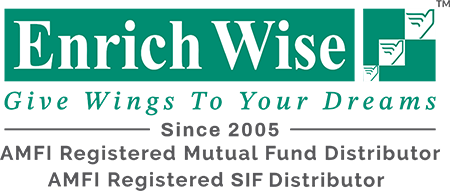Imagine your life goals as different journeys. Some are short and quick, some longer and demanding. For each journey, you need the right vehicle: a scooter for nearby trips, a car for moderate distances, and a truck for heavy, long hauls. Goal based investing works in exactly the same way, matching the right mutual fund to the timeline and purpose of your financial goal.
At Enrichwise, goal based investing is more than picking mutual funds randomly. It is a structured approach designed to help you achieve your goals with confidence and discipline. Our proprietary Journey-Based Process (JBP) and Strategic Rebalancing Plan (SRP) ensure that your investments remain aligned with your financial journey.
What is Goal Based Investing?
Goal based investing is an approach where every investment is aligned to a specific financial goal. Instead of investing without purpose or chasing returns, you define your goal, your time horizon, and your risk appetite, and then select the right investment to meet that objective.
This method not only brings clarity but also keeps you disciplined and focused on what truly matters: achieving your life goals.
At Enrichwise, we make this simple and effective through our Journey-Based Process (JBP).
Understanding Enrichwise’s Journey-Based Process (JBP)
Enrichwise’s Journey-Based Process (JBP) is a unique approach that helps classify your investments based on two key dimensions:
- Time-frame based classification
- Your financial journey
Time-Frame Based Approach:
We classify goals into three broad time frames:
- Short-term (up to 1 year)
- Medium-term (around 3 years)
- Long-term (5 years or more)
These time frames interact with three key variables:
- Needs: The urgency and purpose of the goal
- Money: The capital available for the goal
- Market: Current and expected market conditions
How does JBP work in practice?
- If your need is short-term (within 1 year), your money should avoid stock market exposure. Instead, it should be allocated to safer options like debt mutual funds that are not market-linked. Plus they preserve capital and offer liquidity.
- For medium-term goals (around 3 years), equity mutual funds are preferred due to their growth potential and relative stability compared to investing in individual stocks.
- For long-term goals (5 years or more), you can invest directly in stocks, focusing on quality blue-chip companies for superior long-term growth.
Additionally, JBP emphasizes regular reviews every six months. This ensures your 1-year, 3-year, and 5-year plans stay on track as your life situation and the market evolve.
How to Classify Your Goals Before You Invest
Understanding the nature of your goal is the first step. Goals can be classified into:
Short-Term Goals (0 to 3 years)
Examples: vacations, gadgets, or an emergency fund.
Priority: capital preservation and easy liquidity.
Medium-Term Goals (3 to 5 years)
Examples: car purchase, wedding expenses, or funding a business.
Priority: balance of stability and moderate growth.
Long-Term Goals (5 years or more)
Examples: child’s education, retirement planning, or buying a home.
Priority: long-term growth and higher return potential.
Choosing the Right Mutual Fund for Each Goal
In goal based investing, choosing the right mutual fund for each goal is critical.
For Short-Term Goals:
Select low-risk options like liquid funds or ultra-short-term debt funds that provide capital protection and easy access to money.
For Medium-Term Goals:
Hybrid funds or balanced advantage funds that offer a mix of equity and debt exposure, delivering moderate growth with controlled risk.
For Long-Term Goals:
Equity mutual funds such as large-cap or flexi-cap funds that offer growth potential suitable for wealth creation over long periods.
At Enrichwise, we complement JBP with our Strategic Rebalancing Plan (SRP). SRP ensures that as markets fluctuate and your life evolves, your investments are rebalanced periodically to remain aligned with your goals and risk profile.
How Much Should You Invest for Each Goal?
It is not enough to define your goal and pick a mutual fund. You also need to calculate the amount to invest to ensure you achieve your target.
For example:
If your child’s education costs ₹10 lakh today and you will need this amount in 10 years, accounting for 6% inflation, the future cost will be approximately ₹17.9 lakh.
By investing in an equity mutual fund with an assumed 12% return, you would need a monthly SIP of around ₹7,994.
This disciplined planning helps avoid last-minute financial stress, a hallmark of Enrichwise’s goal based investing approach.
Common Mistakes to Avoid in Goal Based Investing
Many investors make avoidable mistakes when approaching goal based investing:
- Not defining clear goals: Investing without a clear objective leads to confusion and inefficiency.
- Ignoring inflation: Planning for today’s cost without adjusting for inflation results in a shortfall later.
- Choosing the wrong fund type: For example, investing in an equity fund for a short-term goal increases risk unnecessarily.
- Not calculating the required SIP amount: Without proper calculation, your savings may fall short of the goal.
At Enrichwise, we guide clients to avoid these mistakes using the structure provided by JBP and SRP.
Goal based investing is about giving every rupee you invest a purpose. At Enrichwise, our Journey-Based Process (JBP) and Strategic Rebalancing Plan (SRP) help you match the right mutual fund to the right life goal, making your financial journey smooth and disciplined.
Whether you are saving for a vacation, your child’s future, or your own retirement, the right mutual fund strategy ensures you stay focused, avoid unnecessary risks, and build confidence in achieving your dreams.


